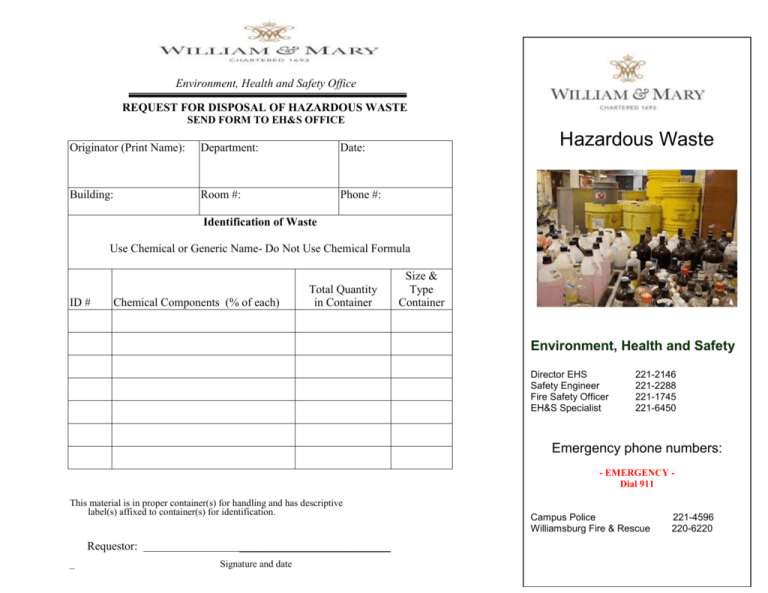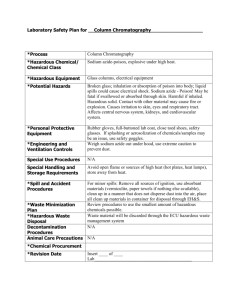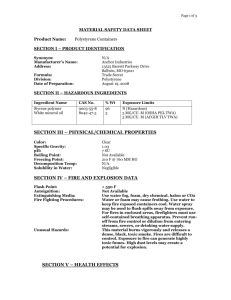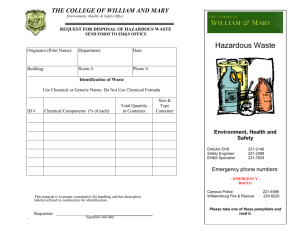Identification of Waste - College of William and Mary
advertisement

Environment, Health and Safety Office REQUEST FOR DISPOSAL OF HAZARDOUS WASTE SEND FORM TO EH&S OFFICE Originator (Print Name): Department: Date: Building: Room #: Phone #: Hazardous Waste Identification of Waste Use Chemical or Generic Name- Do Not Use Chemical Formula ID # Chemical Components (% of each) Total Quantity in Container Size & Type Container Environment, Health and Safety Director EHS Safety Engineer Fire Safety Officer EH&S Specialist 221-2146 221-2288 221-1745 221-6450 Emergency phone numbers: - EMERGENCY Dial 911 This material is in proper container(s) for handling and has descriptive label(s) affixed to container(s) for identification. Requestor: _ __________________________ Signature and date Campus Police Williamsburg Fire & Rescue 221-4596 220-6220 The most effective method of dealing with hazardous waste is to minimize waste generation. You should be sensitive to the proper disposal of any chemicals you use or purchase. Potential Hazardous Wastes at William & Mary Abandoned Unknowns. The problems associated with abandoned unknowns can be avoided with a standard laboratory protocol: label each container with content name, concentration, date chemical was prepared or opened, and your initials. Expiration Date Surpassed. Place special attention to the expiration dates of peroxidizable chemicals. Use or disposal of peroxidizable chemicals before their expiration date is very important. Chemicals from Completed/Discontinued Research or Experiments. When these materials are no longer useful or cannot be recycled, they are considered waste and must be properly identified prior to disposal. Excess Stock with No Likelihood of Use. Contact EH&S to help recycle any excess unused chemicals. Spent Cleaning and Wash Solvents. Spent cleaning and wash solvents are almost always hazardous waste because the solvent or the materials which contaminate the solvent may be hazardous. Waste Paints. Waste paints containing hazardous metals such as lead or hazardous solvents have to be treated as hazardous waste. Used Motor Oil and Filters. Currently oil is recycled. Used oil filters may be disposed of as ordinary waste provided they are drained of free liquid and crushed. Mercury. Mercury is commonly found in instrumentation, thermostats, and thermometers. Mercury can be recycled. The goal for the college is to become a mercury free campus. Electrical Transformers Older electrical transformers often contain Polychlorinated biphenyl (PCB) dielectrics. Disposal of PCB dielectric fluids from equipment is very expensive. Contact the EH&S office to have this equipment evaluated prior to accepting the equipment. Gas Cylinders. Gas cylinders and lecture bottles must be disposed of properly either through the manufacturer or as hazardous waste. Select Agents. Deactivate using a 1:10 bleach solution, and mark with the words “Deactivated,” before disposal through EH&S. Satellite Accumulation Areas (SAA) These are areas where hazardous wastes that are generated as part of the laboratory activity are collected and properly stored until they are transferred to the main accumulation area. If a process routinely creates the same waste stream, a SAA may be the best way to deal with the waste in your area. There are specific requirements for establishing and maintaining a SAA. Contact the EHS Office for guidance. General Rules Management and Disposal of Waste Each laboratory, department, or building where potential hazardous materials are located, should have a designated principal investigator or a building coordinator. This person should be authorized by department heads to establish procedures within the laboratories and/or department. Also, this person must be familiar with the current hazardous material handling and waste disposal procedures established for the campus Hazardous waste must be collected and stored in a temporary storage facility at the Integrated Science Center. Call the EH&S Office to make arrangements for a pick-up date and time. To dispose of waste, submit a waste disposal form (on back of this brochure) to the EH&S Office. Staff from the Environment, Health and Safety office will pick up waste to be disposed of from your location. Empty hazardous materials containers may also be hazardous waste. Refer to the Empty Container Guidelines: http://www.wm.edu/offices/facilities/services/saf ety/hazardwaste/index.php Proper label should be affixed to containers at all times. Labels can be obtained from the Environment, Health and Safety office. Ensure that containers are kept closed except when filling. Chemicals should be segregated according to their chemical compatibility. Never fill containers to the top, allow at least one inch of expansion space. Handle shock sensitive compounds with extreme caution. Contact the Environment, Health, and Safety office to arrange for special handling. Use the appropriate personal protective equipment when dealing with hazardous materials; reference the safety data sheet for guidance.








